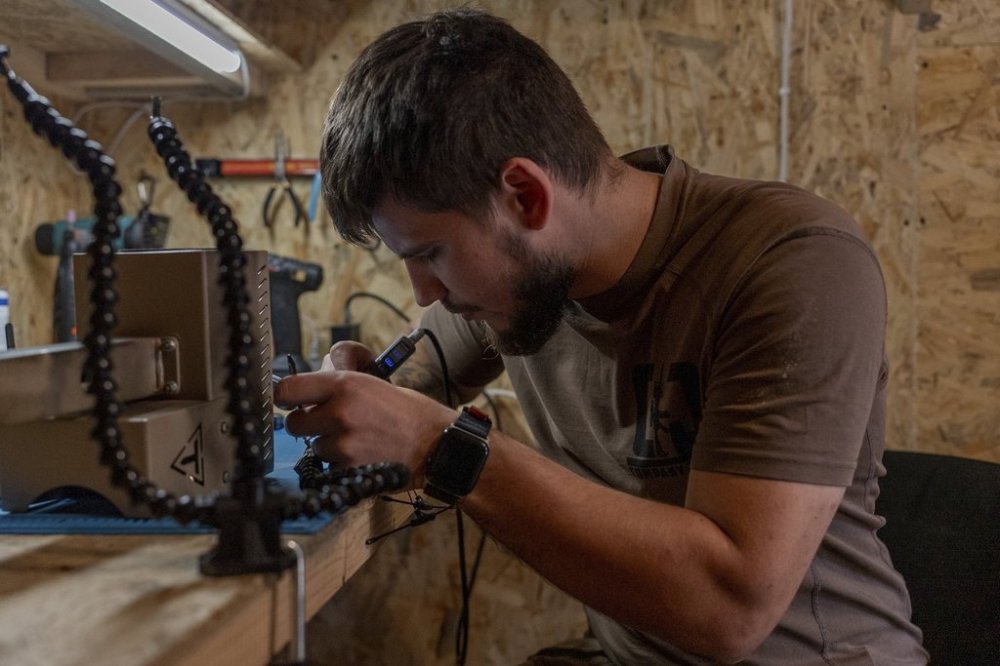World
Ukraine Deploys Remote-Controlled Vehicles to Protect Soldiers

Ukrainian forces are increasingly utilizing remote-controlled armored vehicles to enhance battlefield safety and efficiency, particularly in the conflict-ridden Donetsk region. Amid ongoing threats from Russian drones, these innovative machines are performing essential tasks, reducing the risk to soldiers engaged in dangerous missions.
The use of these vehicles, colloquially referred to as “robots on wheels,” is becoming vital as the Ukrainian military grapples with a sustained shortage of personnel in a conflict that has extended over three and a half years. These remote-controlled units resemble miniature tanks and are capable of transporting supplies, clearing mines, and evacuating casualties.
Commander Miami of the 20th Lyubart Brigade, who requested anonymity in accordance with military protocol, emphasized the technology’s role in minimizing human risk. “It cannot fully replace people,” he stated. “But for a human, it’s far too dangerous.”
The vehicles, predominantly manufactured by Ukrainian companies, range in price from approximately $1,000 to $64,000, depending on their specifications and functionalities. Their deployment along the extensive 1,000-kilometer (620-mile) front line marks a significant shift in modern warfare tactics. The concept of using remote-controlled vehicles is not new; similar technologies were used by the German army during World War II. However, the extensive application of these machines by Ukraine could pave the way for further advancements in their design and utility.
Both Ukrainian and Russian forces have incorporated remote-controlled vehicles into their operations. Miami, who joined the army on the first day of the full-scale invasion in February 2022, has witnessed firsthand the evolution of military roles. Initially serving as an infantryman and later as a drone operator, he remarked, “I couldn’t even imagine that I would become a (drone) pilot. But war is progress, and we cannot stand aside.”
The robotic vehicles employed by Miami’s team are armored and can move on wheels or tracks. They are painted in military colors and are designed to traverse challenging terrain that would pose significant danger to human soldiers. “They arrive in one condition, and we improve them,” Miami noted, highlighting the team’s efforts to enhance the vehicles’ resilience against electronic warfare.
As Miami’s unit begins to integrate these machines into their operations, they primarily use them for logistical support, such as delivering food and ammunition to frontline troops. Akim, another soldier in the unit, explained the importance of these vehicles by stating, “Every time a drone or a robot does something, it means one of our fighters doesn’t have to.”
Before deploying a remote-controlled vehicle, Akim conducts reconnaissance using a drone to scout for obstacles or mines along the planned route. Operating from a cramped basement in Kostiantynivka, less than 10 kilometers from the front lines, he is acutely aware of the ongoing dangers, hearing the sounds of artillery and aerial bombardments. The city, once home to 67,000 residents, is now largely deserted and is increasingly surrounded by Russian forces.
The aerial drone allows Akim to explore the area without endangering his life. “The machine doesn’t get tired,” he noted. “It can carry as much as needed.” In one recent mission, the team loaded a robotic vehicle with 200 kilograms (approximately 440 pounds) of supplies and successfully delivered it to a concealed position in a nearby forest.
Despite their advantages, these robotic vehicles face challenges, including potential vulnerabilities on the battlefield. They typically move at a slow pace of around 6 kilometers per hour, making them easier targets for enemy forces. Miami expressed concerns over the safety of evacuating wounded soldiers using these machines, as risks remain high. “Some refuse to leave because it’s dangerous,” he explained.
Cost is another consideration, with the average vehicle costing around 400,000 hryvnias (approximately $9,700). Miami pointed out that while this price may not seem exorbitant, the costs can accumulate rapidly if multiple units are destroyed in a short timeframe. To enhance their survival, Miami and his team have experimented with modifications, such as welding protective cages and attaching metallic rollers to detect mines.
The ongoing conflict provides immediate feedback that informs the development of new models, enabling Ukrainian forces to adapt to the changing nature of warfare. As the situation evolves, the reliance on remote-controlled vehicles is expected to increase, reflecting a significant shift in military strategy and the ongoing fight for sovereignty in Ukraine.
As the war continues, the integration of technology in combat underscores a broader trend in modern warfare, where adaptability and innovation may prove crucial for survival on the battlefield.
-

 Politics4 weeks ago
Politics4 weeks agoSecwepemc First Nation Seeks Aboriginal Title Over Kamloops Area
-

 World5 months ago
World5 months agoScientists Unearth Ancient Antarctic Ice to Unlock Climate Secrets
-

 Entertainment5 months ago
Entertainment5 months agoTrump and McCormick to Announce $70 Billion Energy Investments
-

 Science5 months ago
Science5 months agoFour Astronauts Return to Earth After International Space Station Mission
-

 Lifestyle5 months ago
Lifestyle5 months agoTransLink Launches Food Truck Program to Boost Revenue in Vancouver
-

 Technology3 months ago
Technology3 months agoApple Notes Enhances Functionality with Markdown Support in macOS 26
-

 Lifestyle3 months ago
Lifestyle3 months agoManitoba’s Burger Champion Shines Again Amid Dining Innovations
-

 Top Stories2 months ago
Top Stories2 months agoUrgent Update: Fatal Crash on Highway 99 Claims Life of Pitt Meadows Man
-

 Politics4 months ago
Politics4 months agoUkrainian Tennis Star Elina Svitolina Faces Death Threats Online
-

 Sports5 months ago
Sports5 months agoSearch Underway for Missing Hunter Amid Hokkaido Bear Emergency
-

 Politics5 months ago
Politics5 months agoCarney Engages First Nations Leaders at Development Law Summit
-

 Technology5 months ago
Technology5 months agoFrosthaven Launches Early Access on July 31, 2025




















